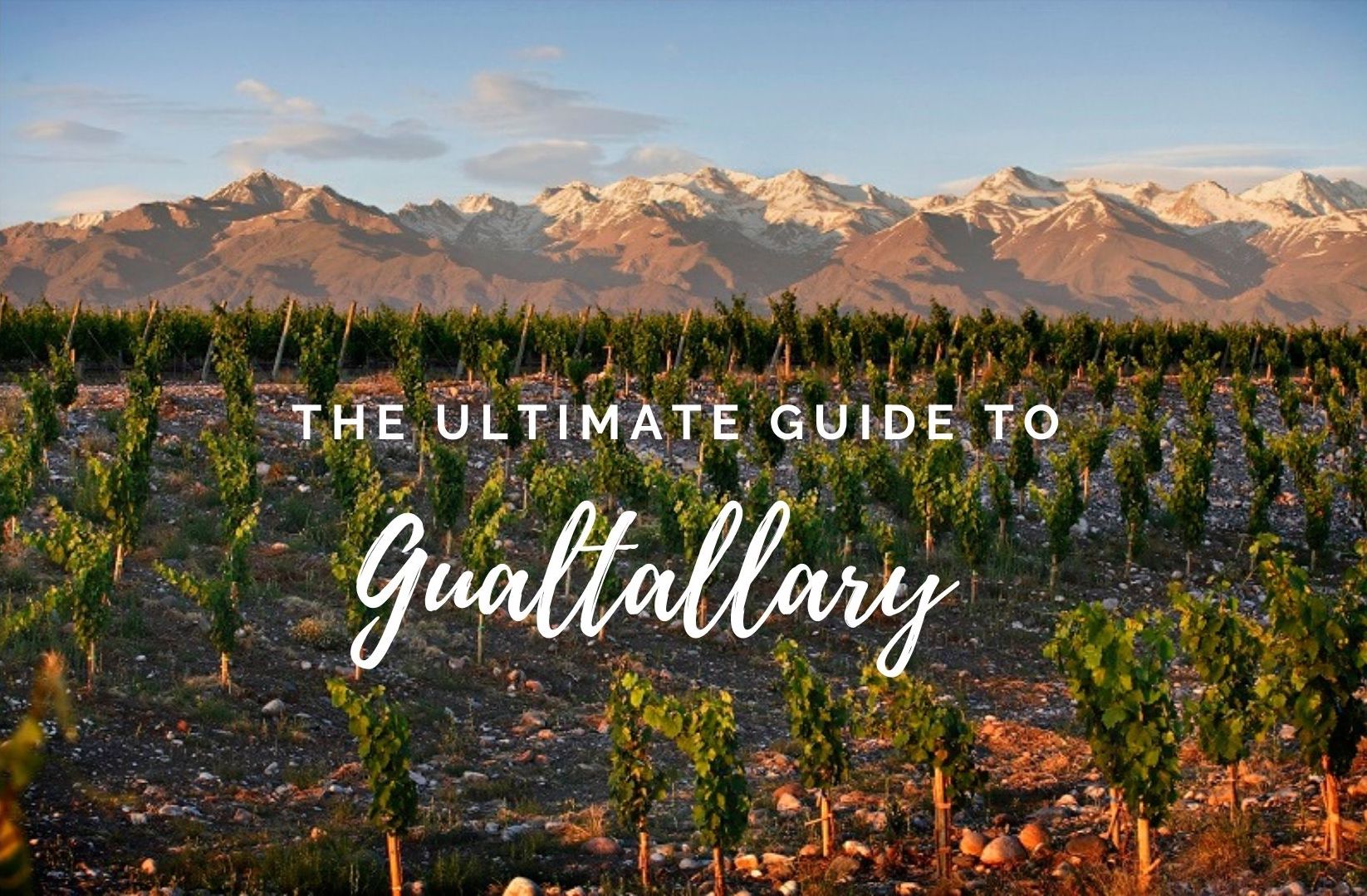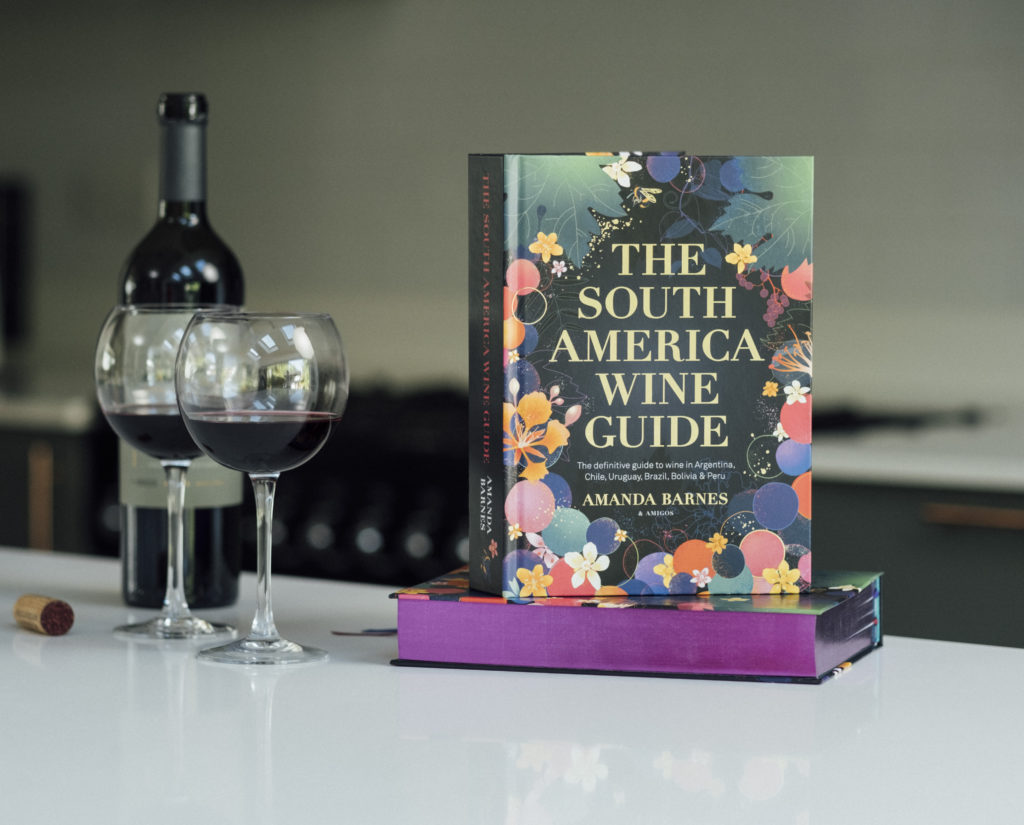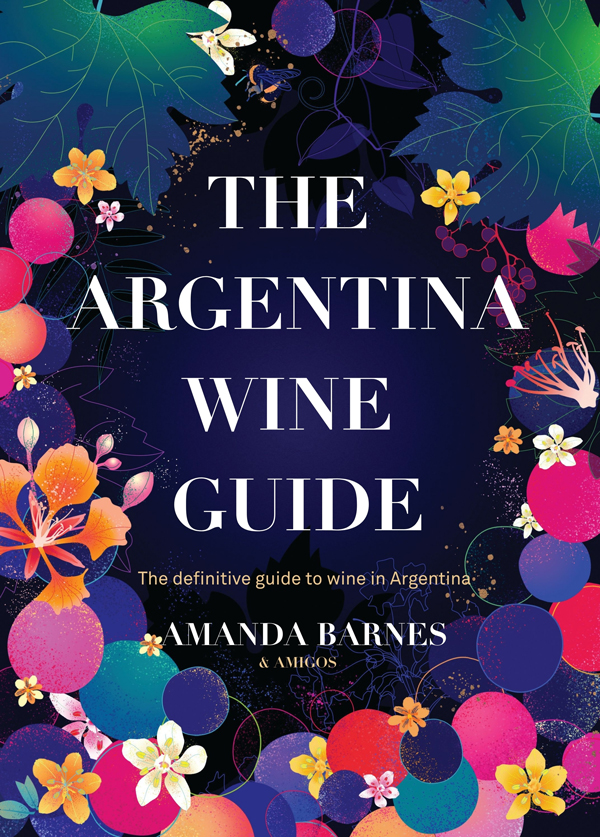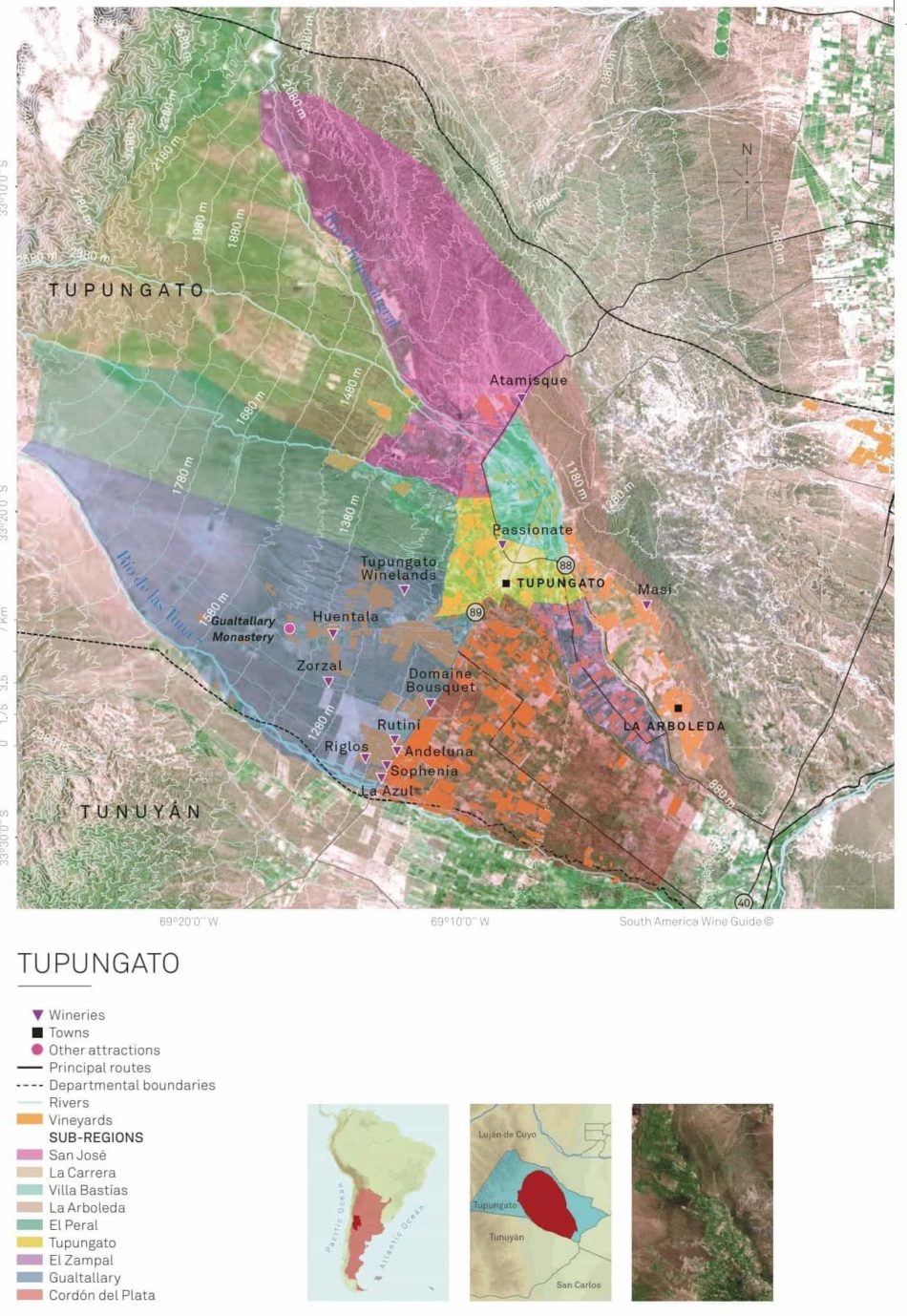If Gualtallary isn’t already the most famous sub-region of Argentina, it probably soon will be. Some of Argentina’s most expensive and idolised wines come from the Gualtallary wine region, which is quite remarkable considering that there were barely any vines here 30 years ago.
Guide to Gualtallary wine region in the Uco Valley
Notable producers in Gualtallary
Quick guide to Gualtallary
Best wines to try from Gualtallary
Map of Gualtallary & Tupungato in the Uco Valley
Guide to Gualtallary wine region
Previously considered too cold and too steep, the first vines were planted in Gualtallary in 1992 by Chandon, which was looking for cool temperatures to make better sparkling wine. In the early and mid-90s other producers also came to the region in search of making fresher white wines too, including Catena Zapata, Doña Paula and Sophenia.
Several of these early plantings were successful in making fresher wines and proving the potential of this new high-altitude region. One of the key winemakers who championed Gualtallary in these early years was Matías Michelini, who was fundamental in the development of Gualtallary portfolios for Doña Paula, Sophenia and Zorzal. Matías quickly earned the nickname ‘green Michelini’ because he started harvesting up to a month earlier than everyone else in a search for freshness and acidity.
As soon as producers moved away from the overripe grapes that were the norm during this period, you could suddenly appreciate the star-bright acidity and chalky texture of both the white and red wines from Gualtallary. Matías Michelini’s early Sauvignon Blanc vintages at Sophenia became some of Argentina’s most promising white wines, and helped put Gualtallary on the map for its potential for making radically different styles of wines in Argentina. Today Matías is no longer considered green, as most other wineries have also brought forward their harvesting dates; and Gualtallary has become renowned for making some of the best white wines in Argentina.
It is actually Chardonnay which I would argue is the star white wine of Gualtallary today. One of the early pioneers of the region, Catena Zapata, has been fundamental in showing the star quality of this variety here — making wines with verve and tension.
Gualtallary’s climate & soil
So cool is the climate in some of the sites in Gualtallary that some of the vineyards are considered Winkler I, comparable to Champagne. However, it isn’t just the cooler temperatures at altitude that make Gualtallary distinctive — but also the soils. Pockets of calcareous deposits, which are considered the holy grail of wine terroir, have been discovered in Gualtallary. The discovery and impact of this tremendous terroir is partly due to the fact that some of South America’s top terroir experts and agronomists work here — Pedro Parra, Luis Reginato, Edy del Popolo, Martín Kaiser, Alejandro Vigil, Leo Erazo, to name just a few.
Gualtallary is, however, enormous, covering a surface area of over 21,000 hectares. The 2,250 hectares of vineyards are spread across diverse sectors of Gualtallary, ranging from areas warm enough to qualify as Winkler III with windblown loess soils, to those at high altitude on limestone soils which qualify as Winkler I. So ‘Gualtallary’, which is still pending GI status, varies enormously in terms of climate and soil characteristics, and the wines duly reflect that.
It is so diverse, in fact, that some producers are proposing the establishment of five sub-GIs within it: Gualtallary Río, Gualtallary La Vencedora, Gualtallary Albo, Gualtallary Monasterio and Gualtallary Las Tunas. However, for ease, I tend to split Gualtallary into the northernmost and highest-altitude area, the central part and the southern area.
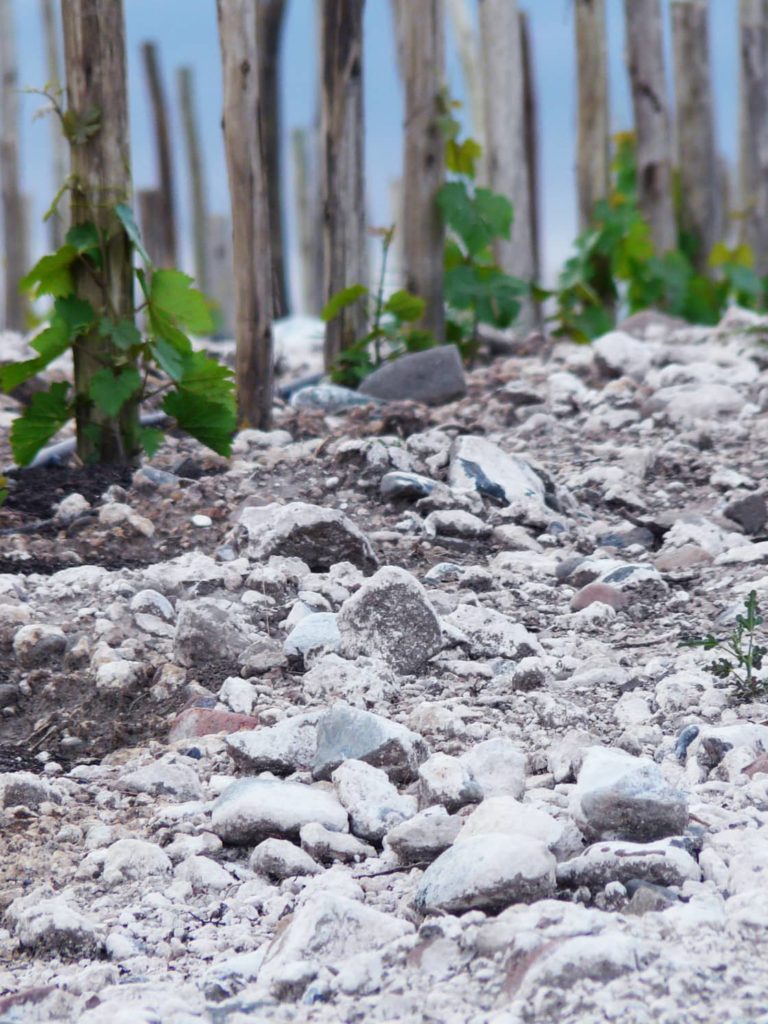
South Gualtallary
The southern area, just to the north of River Las Tunas, has sandy soils with river gravel and almost no calcareous soils, and ranges between Winkler II and III. I particularly like this southern part of Gualtallary for its Cabernet Sauvignon, which delivers in structure and spice.
Central Gualtallary
The central part of the region is the warmest, mostly classified as Winkler III and is where most of its vineyards are located. The soils are mainly sandy but this is where the calcareous deposits begin and there is a lot of caliche intermingled with the sand. As a consequence, the wines tend to be quite aromatic, fruity and approachable.
North Gualtallary
The grand cru of Gualtallary, if you will, is the part that is furthest to the north and has the highest altitude, at over 1,300 m.a.s.l. It is therefore sometimes referred to as Alto Gualtallary. This is where you get the coolest temperatures (ranging from Winkler I to Winkler II) and where the calcium-covered stones gradually get bigger and more numerous until you reach the almost white hillsides of the Sierras del Jaboncillo. The soils in some vineyards are up to 40% limestone here, making them quite unique in Argentina. This is the region that produces Gualtallary’s most distinctive wines, in my opinion, which are also among the most distinctive wines in Argentina, with their chalky texture, sharp tannins and fresh, linear finish.
Main image: Dona Paula’s vineyard in Alto Gualtallary
Want to know more about Gualtallary and the wine regions of Argentina?
ORDER YOUR COPY of The South America Wine Guide now!
E-book AVAILABLE ONLINE too.
Notable producers in Gualtallary
CATENA ZAPATA
The Catena family are well known for putting super-premium Malbec from Gualtallary on the map, but equally as exciting from that same Adrianna vineyard is their glorious ‘White Bones’ and ‘White Stones’ Chardonnay duo.
SOPHENIA
Smart wines from Gualtallary. Altosur is a great-value range (go for the Bonarda!), while Synthesis is their top-of-range with fab Sauvignon Blanc and Cabernet Sauvignon
ZORZAL
Prolific producer making bright, fresh wines. Eggo, their concrete egg-aged wines, is my favorite label for top Cabernet Franc and Sauvignon Blanc
RUTINI
Originally established in 1885 in Eastern Mendoza, this winery has now re-invented itself in Uco Valley. High-end blends are the highlight, made by Mariano di Paola
ANDELUNA
A big player in lower Gualtallary with an excellent restaurant and particularly good Pasionado Cabernet Franc and blend
MICHELINI I MUFATTO
Indie family wines made by winemaker Andrea Mufatto, her husband Gerardo Michelini, and son, Manu, one of Argentina’s most promising young winemakers. Excellent Chenin Blanc, Semillon and Malbec
BODEGA ALEANNA
Alejandro Vigil’s personal El Enemigo line of wines features several vineyards around Mendoza, but some of his top wines come from Gualtallary
PER SE
Edy del Popolo and David Bonomi’s limited-production of classy, high-end Malbec blends from Gualtallary Monasterio
DOMAINE BOUSQUET
Organic winery and vineyard with good value, appetising wines – I especially enjoy their Cabernet Sauvignon. They also have a charming winery hotel and restaurant in Gualtallary
Quick guide to Gualtallary wine region
Hectares planted in Gualtallary
2,250 hectares
Altitude of vineyards
Ranging from 1,080 to 1,600 m.a.s.l.
Soils in Gualtallary
Pockets of calcareous deposits, windblown loess, limestone
Grape varieties and wines
If Chardonnay and Sauvignon Blanc are the two star white varieties of Gualtallary, for me the two star red varieties are Malbec and Cabernet Franc, often blended together. Cabernet Franc from Gualtallary has perfume and spice with a juicy mid-palate, while the Malbecs from Gualtallary have good acidity and a powerful but fine-grained tannic backbone. Alto Gualtallary offers, in my opinion, the Malbec equivalent of Barolo: sometimes it’s a little too powerful in its youth but over the years its elegance reigns supreme.
Winemaker’s perspective on Gualtallary: Edy del Popolo

The character, personality and uniqueness of its wines is the most remarkable thing about Gualtallary. There is huge diversity in Gualtallary, but the northern part is what I call ‘classic Gualtallary’, where we get this matrix of sandy soil with a different proportion of stones depending on the topography. The closer you are to the foothills, the more stones you get. When you reach Monasterio and the hills there, you get these completely white stones — this is the last finger of the Sierras de Jaboncillo, which have a major concentration of chalk. When I first planted bush vines in Gualtallary, it was because the soil was so shallow that you were basically planting in the bedrock and yields are incredibly low. The relationship between the vines and the chalky soil is very intimate and so these are wines with great personality.”
Terroir Selection: Best wines to try from Gualtallary
Gualtallary is a large and diverse GI and home to some of the most exciting wines being made in Argentina.
CATENA ZAPATA, Adrianna Vineyard White Bones
Gualtallary (Alto). $$$$. Drinking window <30 years
Having dug some 70 soil pits per hectare in their Adrianna vineyard, the team released a duo of single-block Chardonnays to showcase how the soils changed the wine. White Bones comes from a soil from an old riverbed that contains fossilised animal bones, while White Stones is from an area with gravel and white stones. My favourite is Bones, an elegant and sophisticated Chardonnay with notes of lavender, ginger biscuits and wet chalk. Divine, and one of the best Chardonnays in South America.
ALTOS LAS HORMIGAS, Appellation Gualtallary
Gualtallary (Alto). $$. Drinking window <25 years
With ‘Doctor Terroir’ Pedro Parra on their team, Altos Las Hormigas have been making wine in Gualtallary since 2011 and each year their wines become more expressive and linear. There’s so much energy in this Malbec with its chalky tannins, vibrant fruit and incredible length. Excellent value for such a thrilling wine.
CATENA ZAPATA, Adrianna Vineyard Fortuna Terrae
Gualtallary (Alto). $$$$. Drinking window <30 years
The Catena family were among the original pioneers of this region and have come to prize their Adrianna vineyard as their real-life Shangri-la. This wine exemplifies their modern quest to make world-class reds at altitude. Elegant yet complex, this beautiful Malbec reveals layers of floral, spice and juicy fruit notes. A mouth-watering and worthy iconic wine that exudes good taste.
BODEGA ALEANNA, Gran Enermigo Gualtallary
Gualtallary (Alto). $$$$. Drinking window <25 years
Winemaker Alejandro Vigil has a flair for Cabernet Franc and this wine, with 15% Malbec blended in, is sublime: filled with dark flowers, black spices and fresh red forest fruit. A nuanced, layered wine with a chalky texture and fresh finish that lingers for moments on the lips. Time has tempered this into an elegant wine that will continue to age well for the decade to come.
DOÑA PAULA, Alluvial Parcel Bush Vines Malbec
Gualtallary (Alto). $$$. Drinking window <18 years
From the first contemporary plantings of bush vines in Argentina located in a top Gualtallary terroir. Perfumed on the nose, with floral and spicy aromas, sweet, concentrated black fruit on the mid-palate and grip, texture and power in the finish. This blockbuster wine has the bold personality of Alto Gualtallary and offers great cellaring potential.
SUPERUCO, Calcáreo Granito Cabernet Franc
Gualtallary (Alto). $$. Drinking window <15 years
Matías Michelini and his brothers have been working in Gualtallary since the early days and SuperUco is the culmination of their family experience in Uco. This Cabernet Franc is a mouth-watering, energetic wine that also shows the richness and concentration you can achieve in these poor, rocky soils. Lashings of mint chocolate, fresh black fruit, black pepper and a stony minerality — delicious!
SUSANA BALBO WINES, Ben Marco Expresivo
Gualtallary (Alto). $$. Drinking window <30 years
This Malbec (85%) and Cabernet Franc (15%) blend is an exotic wine with a complex nose of cassis, black pepper and cardamom. It is lively, fresh and incredibly long, and shows the more feminine side to Gualtallary, while still delivering that trademark minerality in the finish.
RUTINI, Single Vineyard Gualtallary Cabernet Franc
Gualtallary. $$$. Drinking window <20 years
Cabernet Franc can really sing in Gualtallary and Mariano di Paulo has cracked it with this delicious wine. Layers of graphite, jarilla, thyme and forest berries, leads to a long, juicy and peppery finish.
SOPHENIA, Synthesis Sauvignon Blanc
Gualtallary. $$$. Drinking window <15 years
Argentina’s first landmark Sauvignon Blanc, which vibrantly expresses the freshness and aromatic intensity of the region. Herbaceous, zesty and citrus notes with a lean finish makes you salivate for more.
ALTAR UCO, Edad Media Blanco
Gualtallary. $$. Drinking window <15 years
Juampi Michelini blends Chardonnay, Sauvignon Blanc, and Chenin Blanc with the powerful terroir of Gualtallary and a year under a veil of flor to make a very serious wine indeed.
ALTA YARI, Gran Corte
Gualtallary. $$. Drinking window <15 years
This new label from Lujan’s Fabre Montmayou is smashing. Cabernet Franc takes the lead (60%) and Gualtallary comes to the fore with spicy, floral and graphite aromas.
ZORZAL, Eggo Franco
Gualtallary. $$. Drinking window <15 years
With the Michelini clan in charge, it will come as no surprise that this was Argentina’s first line of wines to be solely vinified in concrete eggs. This peppery, floral and spicy Cabernet Franc is refreshing and vibrant.
SOPHENIA, Antisynthesis Field Blend
Gualtallary. $$. Drinking window <15 years
Antisynthesis represents the fresh, feminine side of lower Gualtallary reds. This Cabernet Sauvignon-Malbec field blend is juicy, spicy and goes down far too easily!
Want to know more about Gualtallary
and the wine regions of Uco Valley in Mendoza?
Get your copy of the ARGENTINA WINE GUIDE E-BOOK!
Map of Gualtallary & Tupungato in Uco Valley wine region
You can download all the wine region maps for South America for free on this LINK. Please feel free to share and use the wine region maps while crediting @SouthAmericaWineGuide.
